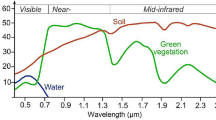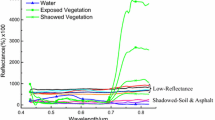Abstract
To prevent confusion between water and buildings in the extraction of urban surface water from hyperspectral data, we analyzed the spectra of shadows and water in hyperspectral images, and proposed an anti-shadow water extraction method. This method first uses the normalized difference vegetation index (NDVI) for initial water extraction, then uses the height of the reflectance peak at 588 nm to eliminate the shadow of buildings. The method was validated by two hyperspectral datacubes, which were obtained for Jiaxing City and Zhoushan City in Zhejiang Province, China. Compared to the common spectral indices used to extract a water body, such as the NDVI, normalized difference water index, hyperspectral difference water index, and index of water index, the proposed method could effectively eliminate the shadow of buildings. The commission error reduced from more than 40% to about 15%, and the Kappa coefficient was increased from 60 and 70% to over 80% for the two datacubes. This indicated that the proposed method can inhibit the shadow of buildings and does not have a regional dependence.













Similar content being viewed by others
References
Cao, R., Li, C., Liu, L., & Wang, J. (2008). Extracting Miyun Reservoir area and monitoring its change based on a revised normalized different water index. Science of Surveying and Mapping, 33(2), 158–160.
Cheng, X., Huang, C., & Ni, B. (2017). Water extraction based on LiDAR data and aerial images using object-oriented technology. Science of Surveying and Mapping, 42(3), 114–119.
Deering, D. W. (1978). Rangeland reflectance characteristics measured by aircraft and spacecraft sensors. Ph.D. thesis, Texas A&M University, College Station, p. 338.
Du, Y., Li, D., & Li, J. (2003). Use of ROC curve to evaluate the correlation factors of cardiovascular risk factors and the determination of appropriate cut points. Guangdong Medical Journal, 24(9), 993–995.
Feyisa, G. L., Meilby, H., Fensholt, R., & Proud, S. R. (2014). Automated water extraction index: A new technique for surface water mapping using Landsat imagery. Remote Sensing of Environment, 140, 23–35.
Gao, Y., Zhu, M., Zhu, J., & Liu, S. (2002). The extraction of residential area on Landsat TM imagery from Red Earth Region in central Jiangxi. Remote Sensing for Land & Resources, 4, 67–69.
Guo, F. (2015). A fast hyperspectral atmospheric correction method based on MODTRAN. Modern Electronics Technique, 38(10), 23–27.
Ji, L., Zhang, L., & Wylie, B. (2009). Analysis of dynamic thresholds for the normalized difference water index. Photogrammetric Engineering & Remote Sensing, 75(11), 1307–1317.
Jia, D., Zhong, S., Li, X., & Peng, B. (2011). Extracting water information from the HSI data of HJ-1A/1B satellite. Science of Surveying and Mapping, 36(4), 128–130.
Jiang, H. (2006). A study on automatic extraction of water information from remote sensing image of Li Jiang County. Tian Shufang: Quaternary Geology of China University of Geoscience.
Jiang, H., Feng, M., Zhu, Y., Lu, N., Huang, J., & Xiao, T. (2014). An automated method for extracting rivers and lakes from Landsat imagery. Remote Sensing, 6(6), 5067–5089.
Kloiber, S. M., Brezonik, P. L., & Bauer, M. E. (2002). Application of Landsat imagery to regional-scale assessments of lake clarity. Water Research, 36(17), 4330–4340.
Manolakis, D., Marden, D., & Shaw, G. A. (2003) Hyperspectral image processing for automatic target detection applications. Lincoln Laboratory Journal, 14(1), 79–116.
McFeeters, S. K. (1996). The use of the normalized difference water index (NDWI) in the delineation of open water features. International Journal of Remote Sensing, 17(7), 1425–1432.
Mo, W., Sun, H., Zhong, S., Huang, Y., & He, L. (2007). Research on the CIWI model and its application. Remote Sensing Information, 5, 16–21.
Shen, Q., & Dongchen, E. (2008). Atmospheric corrections of remote sensing images based on radiative transfer model. Geomatics and Information Science of Wuhan University, 33(1), 85–88.
Teillet, P. M., & Fedosejevs, G. (1995). On the dark target approach to atmospheric correction of remotely sensed data. Canadian Journal of Remote Sensing, 21(4), 374–387.
Wang, Z., Ma, H., Xu, H., & Peng, J. (2010). A method for extracting water contour lines from LiDAR point clouds data. Geomatics and Information Science of Wuhan University, 35(4), 432–435.
Wang, D., Pan, D., Gong, F., & Bai, Y. (2008). Application experimental of hyperspectral imaging sensor AISA+. Chinese Journal of Scientific Instrument, z2, 1167–1169.
Xie, C., Huang, X., Zeng, W., & Fang, X. (2016). A novel water index for urban high-resolution eight-band WorldView-2 imagery. International Journal of Digital Earth, 9(10), 925–941.
Xie, H., Luo, X., Xu, X., Tong, X., Jin, Y., Pan, H., et al. (2014). New hyperspectral difference water index for the extraction of urban water bodies by the use of airborne hyperspectral images. Journal of Applied Remote Sensing, 8(1), 085098.
Xu, H. (2006). Modification of normalised difference water index (NDWI) to enhance open water features in remotely sensed imagery. International Journal of Remote Sensing, 27(14), 3025–3033.
Zha, Y., Gao, J., & Ni, S. (2003). Use of normalized difference built-up index in automatically mapping urban areas from TM imagery. International Journal of Remote Sensing, 24(3), 583–594.
Zhang, L. (2005). The universal pattern decomposition method and the vegetation index based on the UPDM. Ph.D. Thesis, Wuhan University, China.
Zhang, C., Dou, X., Zhang, N., & Ying, Z. (2008). Comparative study of the remote sensing image classification method based on water area estimation. Meteorological and Environmental Sciences, 31(3), 007.
Author information
Authors and Affiliations
Corresponding author
About this article
Cite this article
Yang, J., Liu, C., Shu, R. et al. The Extraction of Urban Surface Water from Hyperspectral Data Based on Spectral Indices. J Indian Soc Remote Sens 46, 1749–1759 (2018). https://doi.org/10.1007/s12524-018-0828-5
Received:
Accepted:
Published:
Issue Date:
DOI: https://doi.org/10.1007/s12524-018-0828-5




